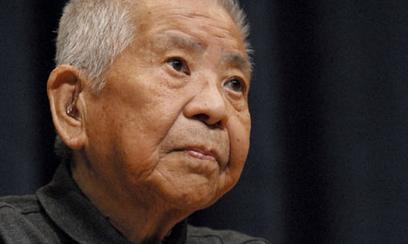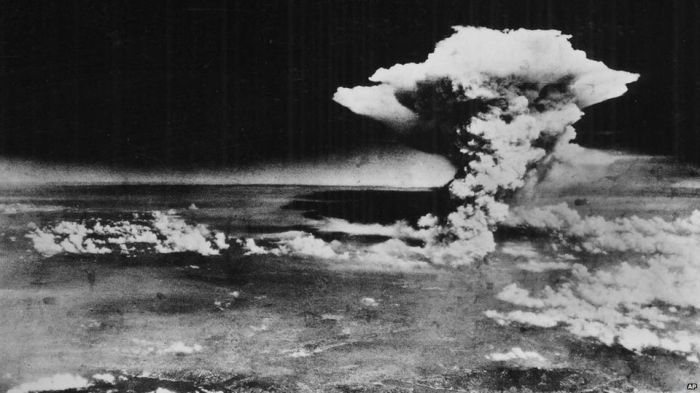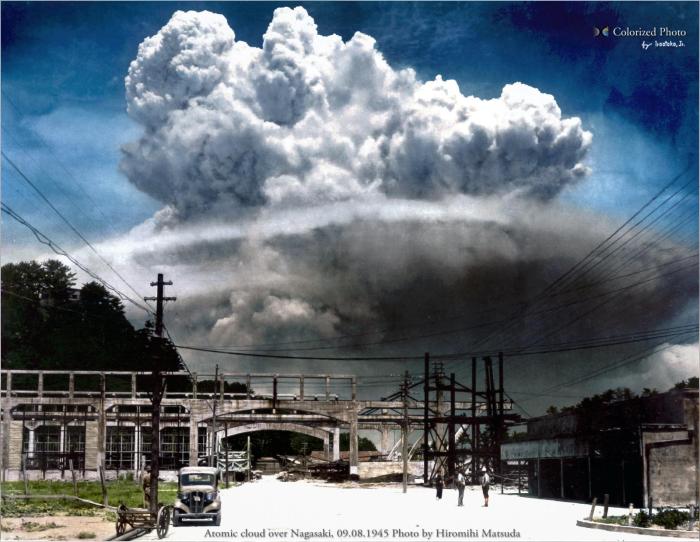Tsutomu Yamaguchi (March 16, 1916 – January 4, 2010) was a survivor of both the Hiroshima and Nagasaki atomic bombings during World War II. Although at least 70 people are known to have been affected by both bombings, he is the only person to have been officially recognized by the government of Japan as surviving both explosions.
Yamaguchi, a resident of Nagasaki, was in Hiroshima on business for his employer Mitsubishi Heavy Industries when the city was bombed at 8:15 am, on August 6, 1945. He returned to Nagasaki the following day, and despite his wounds, he returned to work on August 9, the day of the second atomic bombing. That morning, whilst being berated by his supervisor as “crazy” after describing how one bomb had destroyed the city, the Nagasaki bomb detonated. In 1957, he was recognized as a hibakusha (explosion-affected person) of the Nagasaki bombing, but it was not until March 24, 2009, that the government of Japan officially recognized his presence in Hiroshima three days earlier. He died of stomach cancer on January 4, 2010, at the age of 93.

Early life
Yamaguchi was born on March 16, 1916. He joined Mitsubishi Heavy Industries in the 1930s and worked as a draftsman designing oil tankers.
Second World War
Yamaguchi “never thought Japan should start a war”. He continued his work with Mitsubishi Heavy Industries, but soon Japanese industry began to suffer heavily as resources became scarce and tankers were sunk. As the war ground on, he was so despondent over the state of the country that he considered killing his family with an overdose of sleeping pills in the event that Japan lost.
Hiroshima bombing

Yamaguchi lived and worked in Nagasaki, but in the summer of 1945, he was in Hiroshima for a three-month-long business trip. On August 6, he was preparing to leave the city with two colleagues, Akira Iwanaga and Kuniyoshi Sato, and was on his way to the station when he realised he had forgotten his hanko (a stamp allowing him to travel), and returned to his workplace to get it. At 8:15 am, he was walking towards the docks when the American bomber Enola Gay dropped the Little Boy atomic bomb near the centre of the city, only 3 km away. Yamaguchi recalls seeing the bomber and two small parachutes, before there was “a great flash in the sky, and I was blown over”. The explosion ruptured his eardrums, blinded him temporarily, and left him with serious burns over the left side of the top half of his body. After recovering, he crawled to a shelter, and having rested, he set out to find his colleagues. They had also survived and together they spent the night in an air-raid shelter before returning to Nagasaki the following day. In Nagasaki, he received treatment for his wounds, and despite being heavily bandaged, he reported for work on August 9.
Nagasaki bombing

At 11 am on August 9, Yamaguchi was describing the blast in Hiroshima to his supervisor, when the American bomber Bockscar dropped the Fat Man atomic bomb over the city. His workplace again put him 3 km from ground zero, but this time he was unhurt by the explosion. However, he was unable to replace his now ruined bandages, and he suffered from a high fever for over a week.
Later life
During the Allied occupation of Japan, Yamaguchi worked as a translator for the occupation forces. In the early 1950s, he and his wife, who was also a survivor of the Nagasaki atomic bombing, had two daughters. He later returned to work for Mitsubishi designing oil tankers. When the Japanese government officially recognized atomic bombing survivors as hibakusha in 1957, Yamaguchi’s identification stated only that he had been present at Nagasaki. He was content with this, satisfied that he was relatively healthy, and put the experiences behind him.
As he grew older, his opinions about the use of atomic weapons began to change. In his eighties, he wrote a book about his experiences (Ikasareteiru inochi) as well as a book of poetry and was invited to take part in a 2006 documentary about 165 double A-bomb survivors (known as nijū hibakusha in Japan) called Twice Survived: The Doubly Atomic Bombed of Hiroshima and Nagasaki, which was screened at the United Nations. At the screening, he pleaded for the abolition of atomic weapons.
Yamaguchi became a vocal proponent of nuclear disarmament. He told an interviewer “The reason that I hate the atomic bomb is because of what it does to the dignity of human beings.” Speaking through his daughter during a telephone interview, he said, “I can’t understand why the world cannot understand the agony of the nuclear bombs. How can they keep developing these weapons?”
On December 22, 2009, Canadian movie director James Cameron and author Charles Pellegrino met Yamaguchi while he was in a hospital in Nagasaki, and discussed the idea of making a film about nuclear weapons. “I think it’s Cameron’s and Pellegrino’s destiny to make a film about nuclear weapons,” Yamaguchi said.
Recognition by government
At first, Yamaguchi did not feel the need to draw attention to his double survivor status. However, in later life he began to consider his survival as destiny, so in January 2009, he applied for double recognition. This was accepted by the Japanese government in March 2009, making Yamaguchi the only person officially recognised as a survivor of both bombings. Speaking of the recognition, he said, “My double radiation exposure is now an official government record. It can tell the younger generation the horrifying history of the atomic bombings even after I die.”
Health
Yamaguchi lost hearing in his left ear as a result of the Hiroshima explosion. He also went bald temporarily and his daughter recalls that he was constantly swathed in bandages until she reached the age of 12. Despite this, Yamaguchi went on to lead a healthy life. Late in his life, he began to suffer from radiation-related ailments, including cataracts and acute leukemia.
His wife also suffered radiation poisoning from black rain after the Nagasaki explosion and died in 2010 (age 93) of kidney and liver cancer. All three of their children reported suffering from health problems they blamed on their parents’ exposures, but studies suggest that in general the children of atomic bomb survivors do not have a higher incidence of disease.
What’s up,I read your blog named “A Man Who Survived Both the Hiroshima and Nagasaki Atomic Bombs | The MarkoZen Blog regularly.Your writing style is awesome, keep doing what you’re doing! And you can look our website about Aloe Vera Gel
Multi Maca Saudi Arabia https://foreverpro.info/product/multi-maca/
LikeLike